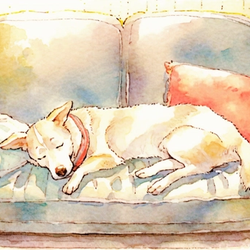Provide Dental Care to Your Pet
When you think about keeping your pet healthy, dental health isn’t likely to be the first thing that comes to mind. However, poor oral health can shorten your pet's lifespan by three to five years. Periodontal disease, also known as gum disease, affects more than 80% of pet cats and dogs, making it the most common disease to affect our pets. The word periodontal means ‘around the tooth.’ It is the result of inflammation and infection of the gums which causes serious bacterial infections that also attack the surrounding tissues. In the early stage of periodontal disease (gingivitis) the gums become swollen and red, and they may bleed. If left untreated, the disease will progress until it affects the underlying bone around the teeth. The bone will dissolve and no longer be able to hold the teeth in place.
Periodontal disease is caused by plaque and tartar buildup on the teeth and along the gumline. The more severe your pet’s dental disease, the more likely it is for deadly bacteria to enter the bloodstream and travel throughout your pet’s body, infecting the heart, liver, kidneys, and other organs. The heart and liver are especially at risk because the bacteria found in the mouth of pets with dental disease are the same bacteria often implicated in heart disease. These bacteria are associated with both inflammation/infection of the interior of the heart and valvular disease in dogs and cats. Several studies have reported an association between periodontal disease and liver cirrhosis. Pets with diabetes have a higher risk of developing dental disease, which can cause it to become more difficult to control. Diabetes makes your pet’s body unable to easily regulate their blood sugar levels, and increased inflammation and infection associated with periodontal disease makes this problem worse. If you have a diabetic pet, it’s especially important to take care of their teeth. The sad fact is that dental disease can be fatal.
Signs of periodontal disease are: Decreased interest in eating dry food; decreased interest in hard treats; chewing more slowly than usual; dropping food from the mouth while chewing; loss of appetite; excessive drooling; frequent pawing or rubbing at the face and/or mouth; new or worsening resistance to having the face/mouth touched; bad breath, discolored teeth or gums, loose teeth, lumps on the gums or under the tongue; red swollen gums; bleeding gums and brownish-yellow tartar on the teeth. When a painful mouth is present, cats may chew less which sometimes causes them to vomit. You need to be your pet’s health guardian because they are silent sufferers due to their innate survival instincts which don’t allow them to demonstrate weakness.
Yearly vet visits for teeth cleaning are extremely important. Your vet may also recommend brushing your pet’s teeth between visits. Most people don’t think about brushing their pet’s teeth, but the payoff is huge. If periodontal disease is caught early, it can be reversed. If your cat won’t allow brushing, even a regular swipe with gauze dipped in water is much better than no tooth care at all. You can also choose dental toys and treats; and ask your vet about toys that are impregnated with enzymes to help reduce plaque or a dental rinse that kills bacteria in your pet’s mouth.
Keep Your Pet’s Weight Under Control
The biggest challenge in addressing the issue of obesity is that many pet owners simply don’t believe there is a problem. In fact, a lot of people think it’s cute. Unfortunately, we are inundated with images in the media of overweight pets, making it difficult to understand what normal looks like. But we need to learn because obesity is a slow, insidious, and silent killer. An animal doesn’t even have to be clinically obese to experience health consequences; being 10% overweight can shorten your pet’s life by one-third.
Recent statistics indicate that about 56% of dogs and 60% of cats in the United States are overweight or obese, making it the most common preventable disease in our pets. Ample evidence now exists proving that fat tissue is biologically active and is filled with blood vessels. The added rich blood creates inflammation which contributes to many serious health complications such as: cancer, diabetes, pancreatitis, chronic kidney disease, heart disease and hypertension, bladder/urinary tract disease, urinary bladder stones, liver disease, degenerative joint disease or arthritis, low thyroid hormone production and anesthetic complications. Obesity may also be an indicator of other diseases, such as hypothyroidism (an underactive thyroid gland) or Cushing’s disease (overactive adrenal glands).
The physiological impact of a few pounds is considerably greater and more concentrated in pets than in people. Five pounds on a cat is catastrophic. Five pounds on a Labrador Retriever is significant. We may think there couldn’t be many consequences of a few extra pounds on a Lab? But the consequences are that his hips are deteriorating, his kidneys are being damaged, and he probably has high blood pressure which is causing several other problems; and his risk of developing cancer is increased. For some smaller dog breeds, extra pounds make an enormous difference. Three extra pounds for canines in the ‘toy’ category is the equivalent of gaining approximately 30 pounds for a person. If your cat's ideal weight is 8 pounds but he'sactually 10 pounds, then he's carrying around an extra 25% of his body weight. Using body weight as a guide, dogs and cats are considered overweight when they weigh 10-20% above their ideal body weight; and they are considered obese when they weigh more than 20% above their ideal body weight. Veterinary experts say just being overweight impacts pet health (it’s a quality-of-life issue as much as a longevity and disease-prevention issue).
The bottom line is: If your veterinarian says that your pet should lose weight, believe him, and take the appropriate action. Both dogs and cats should be fed a measured amount of food daily (i.e., don’t keep filling the bowl). This helps to prevent your pet from overeating, and it allows you to monitor his intake more closely and notice appetite changes, which are an important sign of illness. It is NOT appropriate to simply reduce the volume of their current food. Doing so will cause malnourishment over time. Treats should make up no more than 10% of your pet’s daily calories. With overweight pets, slow, steady weight loss is the healthy way to go. It is important to remember that obese cats who stop eating are at significant risk for developing a potentially life-threatening liver condition called hepatic lipidosis. Losing weight safely is just as important for our pets as not becoming obese to begin with.
Table scraps, too many treats and buffets of food left out 24-7 do not equal love. Walks, play time, petting and quiet time alone with your pet all say “I love you”more effectively than extra food.




